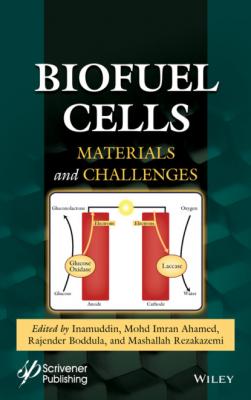Biofuel Cells. Группа авторов
Читать онлайн.| Название | Biofuel Cells |
|---|---|
| Автор произведения | Группа авторов |
| Жанр | Физика |
| Серия | |
| Издательство | Физика |
| Год выпуска | 0 |
| isbn | 9781119725053 |
Cross-linking is an immobilization technique that attempts to ameliorate the downsides of covalent bonding, while still forming a covalent bond to the enzyme. To this end, cross linking agents are added which react with the surface groups in the enzyme surface (Figure 1.4e). Frequently, the amine groups present in the lysine residues have been targeted. Cross-linkers for this functional group have either aldehyde or epoxy terminated ends. Upon reaction with primary amines, aldehydes form imines (Figure 1.5a), creating a covalent double bond between the enzyme and the cross-linker. One of the most common cross linkers, partly due to its low cost, is glutaraldehyde (GA) (Figure 1.5c). This aliphatic cross linker is used, for example, to create bonds between the lysine residues in GOx, laccase and horseradish peroxidase [13, 53, 54]. While most authors have used the GA in solution [53, 54], some have preferred to expose the enzyme-modified electrode to a vapor of the cross-linker [13, 55, 56]. This method is more economical in that the deposition solution can be used for a longer period. Mixtures of enzymes and cross-linkers are reactive, making these solutions unstable. In fact, some precipitates start appearing within minutes in some solutions containing enzyme and cross-linker.
Figure 1.5 Reactions of (a) primary and (b) secondary amines with aldehydes. (c) Main aldehyde-based cross-linkers used for enzyme immobilization. R1 and R2 refer to groups in the enzyme or polymer, while R’ and R” refer to groups in the cross-linker.
Aldehydes can also react with the amine groups present in polymers such as poly(ethyleneimine)s (PEIs) [46]. Branched PEIs (BPEIs)‡ possess primary, secondary and tertiary amines, while linear PEIs (LPEIs) possess almost exclusively secondary amines [57]. Therefore, when aldehydes react with LPEIs, they produce enamines instead (Figure 1.5b). This cross-linking between enzymes and polymers is expected to strengthen the interaction compared to just using the electrostatic entrapment. Indeed, Chung et al. showed improved stability when cross-linking GOx to BPEI-covered carbon nanotubes using two aldehyde cross-linkers [58].
Kwon’s group has recently introduced the use of terephthalaldehyde (Figure 1.5c) as a cross-linker for glucose oxidase and branched poly(ethyleneimine) [58]. They suggest that the conjugation between the C=N bonds and the phenyl group help improve the electron transfer across the whole composite. Furthermore, they tried different sequence of immobilization steps and found that, if the GOx is cross-linked first, it forms aggregates that can be later cross-linked to PEI-covered nanotubes. Using this methodology, they reported an additional 25% increase in their maximum power density compared to their previous approach [59].
Epoxide-based cross-linkers emerged as an alternative to aldehydes [60] driven partly by the reported toxicity of glutaraldehyde [61]. Epoxide groups are reactive to amine, hydroxyl and carboxyl functional groups [62]. When reacting with primary or secondary amines, they yield secondary or tertiary amines respectively and secondary alcohols (Figures 1.6a, b). Polyethers containing epoxide ends have been the most popular epoxide cross-linkers in enzymatic fuel cells (Figure 1.6c). Ethylene glycol diglycidyl ether (EGDGE), for example, has been the preferred cross-linker for the LPEI based hydrogels [54, 63–65]. Longer epoxide-terminated polyethers are generally known as poly (ethylene glycol) diglycidyl ether (PEGDGE) and are commercially available in a variety of chain lengths. These molecules have also been used to cross-link GOx in the presence of poly(Nvinylimidazole) [56] and poly(allylamine) [66] derivatives. A number of studies have been carried out to explore the effect of the amount of cross-linker in the electrode performance. Hickey et al. reported that the apparent Michaelis–Menten constant
Figure 1.6 Reactions of (a) primary and (b) secondary amines with epoxides. (c) Main epoxide-based cross-linkers used for enzyme immobilization. R1 and R2 refer to groups in the enzyme or polymer, while R’ refers to groups in the cross-linker.
Different immobilization techniques can be coupled together. For example, Christwardana et al. employed a two-step immobilization of laccase and GOx. First, they created layer-by-layer (LbL) assemblies of each enzyme and PEI on the surface of carbon nanotubes. Afterwards, the modified electrode was exposed to GA crosslinking the enzymes and (although not explicitly stated by them) probably the PEI as well. The cell containing an enzymatic biocathode including the GA cross-linking step showed a higher maximum power density compared to the one fabricated just by LbL. This increase in performance was, however, a modest 3.6% [53].
1.3.2 Preparation of Microbial Bioelectrodes
Preparation of microbial bioelectrodes starts with the selection of an inoculum source; electroactive inoculum sources, ecological role (synergistic relationships), metabolic pathways involved in extracellular electron transfer and production of value-added metabolites are some topics addressed via microbial bioelectrocatalysis.
The preparation of microbial electrodes requires the use of electroactive microorganisms, which are found in different natural and artificial niches [67]. Among the natural niches are marine sediments and different types of soils [68]. Artificial sources of electroactive microorganisms are urban and industrial wastewater [69], and compost and sludge from treatment plants [70]. Another frequent source of inoculum is the effluent and biofilm from another operating microbial electrochemical cell [67]. Electroactive species have been tested in pure cultures, mainly of Geobacter spp. and Shewanella spp. [71]. These bacterial species have been studied in depth because they show the two principal electron transfer mechanisms,
